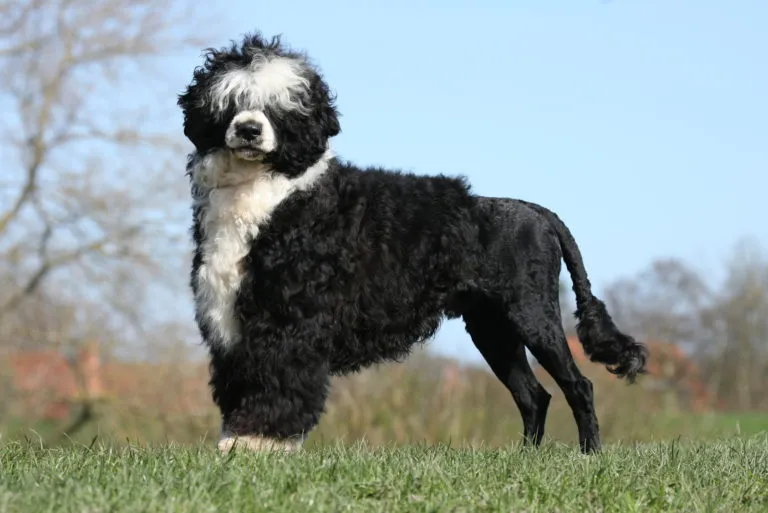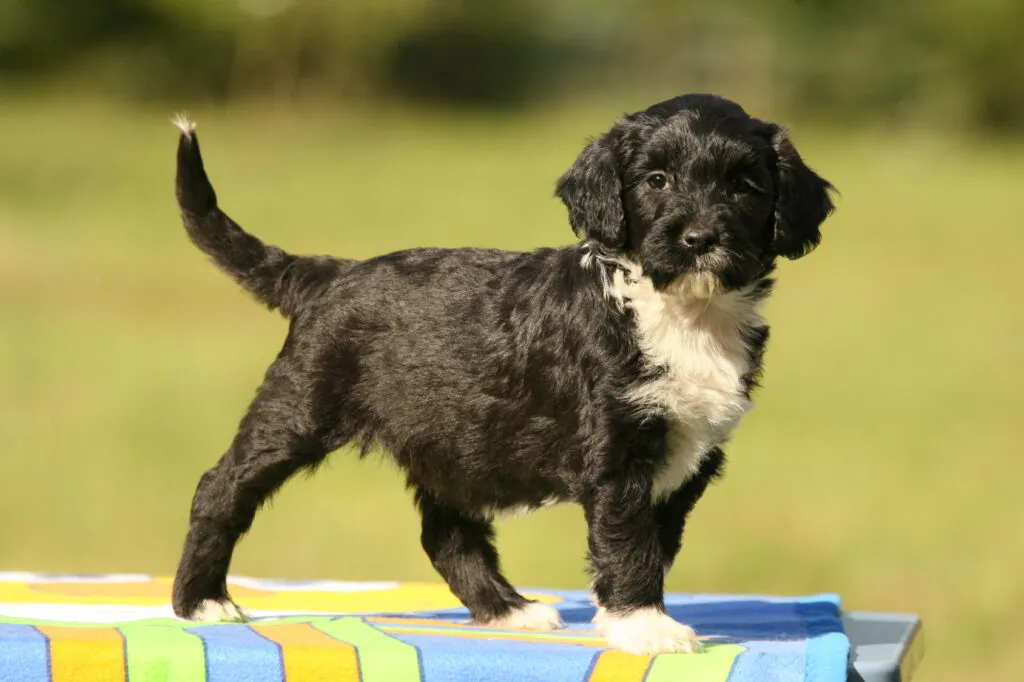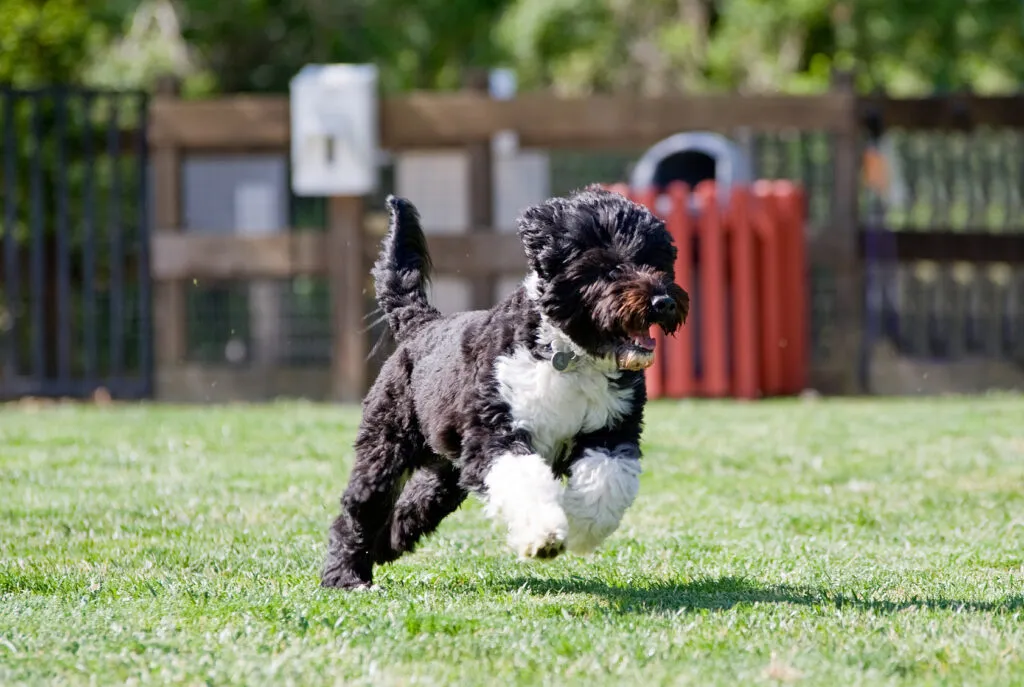Medium Size Poodle
The official and very melodious name of this four-legged friend is: Cão de Água Português, translated as "Portuguese Water Dog" or simply "Portie". In recent years, the breed has gained increasing popularity in Europe and the USA. If you are looking for a lively dog with a unique personality, this four-legged friend might become your friend for life.

© Zottelhund / stock.adobe.com
The Portuguese Water Dog, originally bred to assist fishermen in the Iberian Peninsula, faced near extinction but has since made a remarkable recovery thanks to dedicated enthusiasts
The sporty four-legged friend is most noticeable when it strides in the typical lion cut: The front half of the body is covered with wavy, long fur like a mane, while the back is almost shorn bald – except for the tail tip, which flaunts long hair like a lion’s.
However, in everyday life, it’s more practical to keep the fur evenly short over the entire body, which is why many shaved Portuguese Water Dogs appear more inconspicuous at first glance.
Reaching a height of up to 57cm at the withers, these dogs can weigh up to 25kg, with females being slightly lighter at up to 52cm height.
These droopy-eared water dogs are predominantly seen in black and brown, either solid-coloured or spotted. The white portion should not exceed one-third. Besides the long, wavy-haired variant, there are also shorter-haired and curlier specimens.
The ancestors of the Cão de Água Português likely arrived on the Iberian Peninsula in pre-Christian times with traders, where centuries later they were crossbred with herding dogs. During exploration voyages in the 15th and 16th centuries, these water-loving pals were on board, delivering messages between fleet ships.
Traditionally, these “water dogs” helped Portuguese fishermen in their daily work: accompanying boats, guarding the catch, rescuing those overboard and retrieving escaped fish.
However, with increasing mechanisation, the need for these all-rounders in the water declined, and Portuguese water dogs faced extinction twice in the 20th century. This is evidenced by an entry in the “Guinness Book of Records” from 1970, listing the Cão de Água Português with around 50 specimens as the rarest dog in the world at that time.
Thanks to some dedicated American and Portuguese dog enthusiasts, the breed survived these tough times. Today, the number of Portuguese Water Dogs is continuously growing, sometimes more than desirable, as more and more inexperienced people try to profit from breeding this charming breed. Many Portuguese Water Dogs live in Scandinavia, but the largest population is in the USA, estimated at over 10,000.
Bo and Sunny, the two Portuguese Water Dogs of former US President Barack Obama, have significantly contributed to the breed’s fame there.
 © Zottelhund / stock.adobe.com
© Zottelhund / stock.adobe.com
The shaggy appearance might be deceptive, but the Cão de Água Português is a rather wilful dog with a strong temperament. It tends towards territorial behaviour and is considered “quarrelsome” according to the standard. Consistent training is needed to ensure harmonious living with this four-legged friend.
But then, you will enjoy the numerous advantages of this breed: the Portuguese Water Dog is considered frugal, loyal, very clever, and always ready to experience new adventures with its humans.
Its small stubbornness requires smart training with foresight: This four-legged friend needs a clear place in the hierarchy; otherwise, it will repeatedly try to follow its own agenda. Harshness is misplaced and would only unsettle the clever dog.
Consistency is crucial: Once rules are introduced, all pack members should stick to them – without exception and regardless of how cute the Portuguese looks while possibly pleading for a spot in the bed. Clarify within the family what the four-legged friend is allowed and not allowed, so everyone adheres to the rules.
Attending puppy playtime and dog training school is beneficial for many dogs, but the Portuguese Water Dog significantly benefits from playtime and learning with others as it requires extensive socialisation with both humans and dogs to avoid becoming eccentric in adulthood. Always remember that an agile sports friend like this can only exhibit well-behaved manners if adequately occupied.
Today’s Cão de Água Português is based on a relatively small gene pool of only about 50 dogs, which were used to continue breeding the breed in the 1970s. Consequently, some hereditary diseases have become more prevalent, but these can be well controlled today. The A and O for a healthy Portuguese Water Dog is a responsible breeder who breeds with expertise and has their animals examined accordingly before use.
Genetic testing can, for instance, exclude the risk of blindness due to Progressive Retinal Atrophy since this autosomal-recessive disease can appear even in clinically healthy parents if one of them is a carrier. Similarly, genetic tests can help prevent dangers of the heart disease Juvenile Dilated Cardiomyopathy and Gangliosidosis, a lipid storage disorder.
Like many four-legged friends, the Portuguese Water Dog can suffer from hip dysplasia (HD). Not only can the breeder prevent this through appropriate examinations of the parent animals, but as an owner, you also have a role: Ensure your puppy’s movements are always age-appropriate, and avoid joint-straining sports with jumps or fast running until at least 15 months of age.
A healthy Cão de Água Português can live up to 14 years.
Whether dry or wet food, meat forms the main component of a healthy dog diet! Therefore, rely on a meat-based diet with high-quality proteins – grain-free and certainly without sugar. If you are welcoming a puppy, initially continue feeding it with its known food and transition to new food gradually to avoid additional stress from a dietary change amid an environmental change.
Once it feels at home, you can slowly mix more of the new food with the old. A high-quality feed can be recognised by meat being the first ingredient listed. This also applies to treats – avoid grain and wheat snacks in these too. Dental hygiene treats, dried chews like beef ears or meat chunks for dogs are good alternatives that your four-legged friend will enjoy.
Always ensure a diet suited to its energy needs and reduce portions before turning your Portuguese Water Dog into a chubby. Fresh water should always be available.
A Cão de Água Português in show cut looks impressive, but this requires a lot of work. If you don’t plan to enter shows with your dog, the effort is less, but regular coat care should not be underestimated: it is essential for your Portie’s wellbeing. You should groom it once or twice a week.
For this, you will need both coarse and fine combs and a brush. For cutting, you can opt for either the classic lion cut or simply trim all the hair short. This easier-to-maintain cut is called the Retriever Clip. If you do not want to visit a dog groomer every few weeks, you can trim your Cão de Água Português yourself with a quality clipper.
Regularly trim the hair between the paws with a rounded-tip paw scissor and check the claws – these should be trimmed if they become too long. If necessary, you can also bathe your Portie – use a dog shampoo for long-haired breeds, but be aware that using a conditioner is not always advisable, as excessively soft hair is more prone to tangles. The same applies to the coat variants within the breed: dogs with harsher coats are less prone to tangles.
 © Canadeez / stock.adobe.com
© Canadeez / stock.adobe.com
Boredom is guaranteed not with a Portie: the adventurous four-legged friend is up for almost any fun. And you should encourage this, as the Cão de Água Português needs tasks that train both its body and mind.
With such a versatile dog, you have a wide range of options to keep it variedly occupied: Many Porties love agility sports, where they must overcome various obstacles faultlessly and at speed. But dog dancing, flyball, tricks or obedience are also ideal sports for this all-rounder.
In search and rescue operations, it can be as valuable as in therapy work, provided it has completed the appropriate training. Of course, water work holds a special place for a water dog.
In Portugal and the USA, there are even special water competitions for ambitious swimmers: retrieving and diving in the water are central activities.
Look into these Water Trials, which are sure to offer inspiration for any Portie owner. For all activities, remember: train moderately and always suited to the age and fitness level of your dog.
Do you have dog experience and are looking for a companion with a mind of its own for an active (family) life? Then the Cão de Água Português could be the optimal choice to enrich your life. Dogs that live with children or pets like cats should be properly socialised from a young age. Then, the Portie can make an excellent companion for your two-legged offspring, with whom it loves to frolic and play.
Of course, always supervise young children with it and ensure the four-legged friend has retreat options. The responsibility for the care of the Portie always lies with the adults. So, plan beforehand the time you’ll spend daily with your Portie – during play, outdoors, and also with the coat care.
Speaking of coat care: the Portuguese Water Dog sheds little, but this is no guarantee of being hypoallergenic. If there is suspicion of a pet hair allergy, get it checked by a doctor and spend considerable time in a Portie household before making the final decision.
This active dog can also be kept in a spacious city flat, provided you are not a homebody. Ideally, the four-legged friend should have a secure garden to roam freely and a home in the countryside for joint exploration excursions.
Due to its somewhat stubborn nature, the Portuguese Water Dog is only partially suitable for novice dog owners. Anyone without dog experience who takes in a Portie should definitely attend puppy playtime and dog school with the newcomer and immerse themselves deeply in the basics of dog training. Also, conversations with experienced dog owners can be very helpful.
The Cão de Água Português is not a commonly seen dog. Even if you may have to accept waiting times or travel far: invest time in searching for a good breeder – and then also the corresponding money! Steer clear of animal traders or so-called hobby breeders who breed multiple breeds.
Claims like “The dog doesn’t need papers if you don’t intend to breed!” indicate a lack of reliability! An ancestry certificate from a club belonging to the FCI is a minimum mark ensuring you get a genuine Portie. No breeder who invests expertise and time in healthy, typical, and strong-charactered puppies will forego papers.
Visit the breeder’s home for an impression of the parent animals and your puppy’s environment and discuss the breed with the breeder. Puppies move out at the earliest at eight weeks old, after being dewormed and vaccinated multiple times. Be sure to follow up on the subsequent vaccination appointments.
If you want to adopt an adult Portie, first check the local animal shelter. There are often four-legged friends looking for a new home there, just as sporty and characterful, eager to share life with you.
Otherwise, turn to the internet: purebred water dogs and charming mixes are often in search of a new home. Get extensive information about the potential new companion’s history and, if adopting a dog from abroad, understand the requirements for a smooth relocation.
We wish you delight with your multifaceted Cão de Água Português!
Fans of the Bearded Collie agree that those who aren't familiar with this dog breed simply have to get acquainted with it. And those who have experienced how a Bearded Collie bolts across meadows with its flowing fur, how it rolls around full of energy and joy and how it attentively and observantly takes into account its owners wishes become simply addicted to this original dog breed and its unique charm.
The Goldendoodle isn't a breed, but a pairing between Golden Retrievers and Medium or Standard Poodles. Marketed as a low-maintenance dog for allergy sufferers, this hybrid is enjoying increasing popularity amongst dog lovers, similar to the Labradoodle.